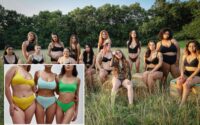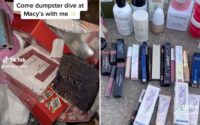Legendary designer Patricia Field on fashion and celeb clients
Patricia Field shocked audiences when she put the actress Sarah Jessica Parker in a bargain-bin tutu for the opening credits of HBO’s “Sex and the City.” Yet as the legendary costume designer reveals in her new memoir, “Pat in the City” (Dey Street Books), that was hardly her most audacious idea.
When Field — by then almost 60 and an underground legend — first met “Sex” producer Darren Star to talk about the show, she brought a book of images of the raven-haired 1950s bombshell Bettie Page. Field thought the so-called “queen of pinups” the “perfect” reference for “Sex,” about four sexually liberated single women in Manhattan. But when Star saw Page’s bondage photos, he balked.
“Surveying the pinup bound in chains with shackles around her ankles and neck (and a fantastic little leopard bikini), or the one of her strung up with a ball gag between her perfectly painted red lips, Darren said, ‘That’s a little much,’” Field writes in her book. “I took the note. But it was clear that he appreciated my aesthetic considerations, even if this one took it a step too far.”

Taking things a step too far is kind of Field’s thing. The flame-haired fashionista has made a career of pushing the envelope, of embracing the outlandish, of living — and dressing — to the hilt.
“As zany as whatever comes out of my mouth or the clothes I throw on people’s backs, my aim is never to be a contrarian for the sake of it,” Field writes. “I’m not a big believer in going against the tide, I like to get on my surfboard and ride it. From fun comes good things.”
Field was born on Feb. 12, 1942, on the Upper East Side, but spent much of her childhood in Astoria, Queens, where her Greek grandmother and three unmarried aunts lived. When she was 5, she got a cowgirl outfit, complete with fringed suede vest, miniskirt, square-toed boots and white Gene Autry-style hat. “I never took it off,” Field writes about her prized get-up. Even then, “I already understood that fashion and costume were one and the same.”


Field — the oldest daughter of a tailor and a dry-cleaner — took that attitude to heart when she opened her eponymous shop in 1971. She filled it with fantasy clothes: corsets and plastic see-through dresses, aggressive strong-shouldered jackets and super tight stretchy pants, and lots of sequins and fake eyelashes and wigs. “Think Jessica Rabbit meets Iggy Pop,” she writes.
Field had studied philosophy and political science at NYU, but after graduation she found herself gravitating to what she knew: clothes. She worked as a buyer for a discount department store before she and a girlfriend opened up their own Greenwich Village spot called Pants Pub, which catered to the college crowd. It led to Patricia Field, her shop at 10 E. 8th St., which peddled a more sophisticated, more ironic, more irreverent kind of fashion.
One of its first celebrity clients, Patti Smith, “descended the shop’s steps” in a floor-length olive green mink, looking like “a magical hobo or royalty who had fallen on hard times.” The punk rocker was a “very good customer,” though Field lamented that the perpetually disheveled Smith made the delicate chiffon blouses she sourced from Paris look “all wrinkled and crappy.”


Jean-Michel Basquiat sat on the floor painting worker’s jumpsuits that Field then sold for $25 a pop. Keith Haring drew a mural on the shop’s window. RuPaul modeled for her. Trans nightlife diva Amanda Lepore worked the makeup counter. Field hired club kids and drag queens to man the store — often finding them on the dance floor at Area, Boy Bar or Paradise Garage (the after-hours joint where “no liquor was served, only drugs”). One almost set the place on fire when he threw his lit cigarette in the trash.
Her “children,” as she called them, enjoyed wielding the power that came with working at Manhattan’s coolest store. They made fun of customer Marc Jacobs’ dorky dad jeans. They threw out John F. Kennedy Jr. when he called them “a bunch of freaks” — though they let his then-girlfriend Daryl Hannah stay. They refused to unlock the doors for Madonna when the pop princess showed up an hour before the store opened. (Celebs, her staffers maintained, could shop with everyone else.)
Still, the stars flocked there. Matt Dillon, “in his gorgeous heyday,” came in and gave the crowd a show when he tried on jeans without any underwear. Foxy Brown almost got into a fight with a manager. Cardi B paid for her dance gear back when she worked as a stripper entirely in $1 bills. Lenny Kravitz once brought his mother, actress Roxie Roker, and she bought sunglasses that she wore in the hospital when she was dying of cancer.

“She felt like they made her glamorous,” Kravitz later told the employee who sold them to her. “They were her favorite thing before she died.”
”I’ve come to a place where people want to know my story, forcing me to look back on my life, which is something I’m not used to. I prefer to keep looking ahead.”
Patricia Field
Not everyone was a fan. Foo Fighters drummer Taylor Hawkins, a loyal customer, once brought his bandmates there before an awards show. Frontman Dave Grohl took one look at all the “rhinestones, pasties, feather boas, wigs, platform shoes and pleather” and “immediately turned around and left.”

Field first designed costumes in 1987 for the erotic thriller “Lady Beware,” in which Diane Lane plays a window dresser. She met Sarah Jessica Parker while working on the 1995 film “Miami Rhapsody,” and the two hit it off. Another designer had done the clothes for the “Sex and the City” pilot in 1997, but Parker did not like the results and suggested Star meet Field.
It wasn’t all smooth sailing. Field wailed that Cynthia Nixon wanted drab suits for her lawyer character, Miranda. “The character was, in Cynthia’s own words, ‘smart and independent and determined,’” Field writes. “Did that also mean she had to look terrible? No!” Kristin Davis clung to her preppy A-line skirts and feared anything too sexy. “I practically had to pry the Ralph Lauren sweater sets from her hands to get some tailored Prada on her,” Field recalls.

She almost lost it when John Corbett — who played one of Parker’s love interests, Aiden — arrived on set “loaded down with heavy pieces of turquoise jewelry as if he’d been on a shopping spree at a Navajo Nation gift shop.” When he insisted on wearing them on screen, Field said, “Are you a cowboy? Get that turquoise the f–k out of here.” They negotiated down to two pieces of the dreaded stone.
Yet in the end, the actors learned to trust her instincts, and let her add some color, whimsy and sex into their wardrobes. Field herself became a celebrity, designing shoes for Payless and a bottle for Coca-Cola.
At 81, Field has a new store, Patricia Field ArtFashion, on the Lower East Side, and consults on the wardrobe for the hit show “Emily in Paris.”
“I’ve come to a place where people want to know my story, forcing me to look back on my life, which is something I’m not used to,” Field writes. “I prefer to keep looking ahead.”


